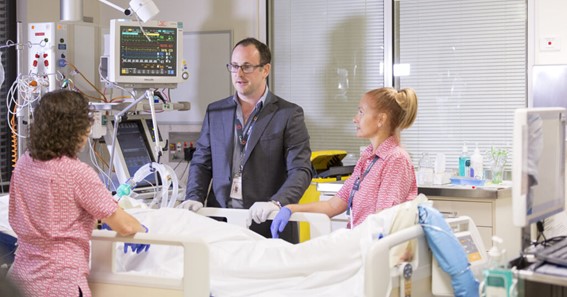Are you curious to know what is a stepdown unit? You have come to the right place as I am going to tell you everything about a stepdown unit in a very simple explanation. Without further discussion let’s begin to know what is a stepdown unit?
In the complex landscape of healthcare, various specialized units and departments work together to provide comprehensive care to patients. One such unit that plays a crucial role in patient management is the Stepdown Unit. In this blog post, we will explore the concept of a Stepdown Unit, its purpose, and the vital role it plays in the continuum of care.
What Is A Stepdown Unit?
A Stepdown Unit, also known as an Intermediate Care Unit (IMCU) or Progressive Care Unit (PCU), is a specialized area within a hospital that bridges the gap between the Intensive Care Unit (ICU) and the general medical-surgical units. It is designed to care for patients who require a higher level of monitoring and intervention than what is typically provided on the general floor but may not need the intensive interventions provided in the ICU.
Purpose and Function:
The primary purpose of a Stepdown Unit is to provide a level of care that falls between the intensive monitoring and interventions offered in the ICU and the general care provided on the medical-surgical units. It serves as a transitional space for patients who are stable but still require specialized monitoring and treatments.
- Monitoring and Observation: Patients in the Stepdown Unit often require continuous monitoring of vital signs, cardiac rhythms, oxygen saturation levels, and other parameters. This allows healthcare providers to closely monitor their condition and detect any changes that may require immediate intervention.
- Specialized Care: Stepdown Units are staffed with a multidisciplinary team of healthcare professionals, including nurses, respiratory therapists, and other specialized clinicians. This team is trained to provide specialized care, administer medications, manage complex treatments, and respond to emergencies promptly.
- Transitional Support: The Stepdown Unit serves as a transitional space for patients who are stepping down from the ICU but still require close monitoring and interventions. It provides a gradual transition to a lower level of care, allowing patients to recover and regain their strength before being transferred to a general medical-surgical unit or discharged home.
- Collaboration and Communication: Stepdown Units foster collaboration and communication among healthcare providers. The team works closely with the ICU staff, consulting physicians, and other specialists to ensure seamless continuity of care and timely decision-making.
Patient Conditions in the Stepdown Unit:
Patients admitted to the Stepdown Unit may have various conditions, including but not limited to:
- Post-operative patients who require close monitoring and management of pain, wound healing, and post-surgical complications.
- Patients with cardiac conditions, such as congestive heart failure or acute myocardial infarction, who require cardiac monitoring and intervention.
- Individuals with respiratory conditions, such as chronic obstructive pulmonary disease (COPD) or acute respiratory distress syndrome (ARDS), who need specialized respiratory support.
- Patients with complex medical conditions who require frequent assessments, intravenous medications, and other interventions.
Conclusion:
The Stepdown Unit plays a vital role in the continuum of care by providing a level of monitoring and specialized intervention that bridges the gap between the Intensive Care Unit and the general medical-surgical units. This specialized unit ensures that patients receive the appropriate level of care based on their condition, facilitating a smooth transition towards recovery. With its dedicated healthcare professionals, advanced monitoring capabilities, and collaborative approach, the Stepdown Unit is an essential component of modern healthcare, offering optimal care and support to patients during their healing journey.
To Figure Out Such Kind Things On Shortestt
FAQ
What Kind Of Patients Are On A Step Down Unit?
Step-down units include patients recovering from acute injuries, sudden and chronic illnesses, surgical procedures, heart attacks, strokes, and more. It can also include patients on long-term ventilation, non-invasive ventilation, and those requiring coronary care.
Is Stepdown The Same As Pcu?
Step-down units (SDUs), also known as progressive care units (PCUs), provide intermediate-level care to patients transitioning from the ICU to a general medical-surgical floor. You can also find step-down nurses in rehabilitation facilities, which treat long-term patients on the mend from serious injuries or illnesses.
What Is The Role Of A Step Down Unit Nurse?
The Stepdown Registered Nurse (RN) delivers patient care utilizing the nursing process through data collection and assessment, identifying and determining the priority of patient’s problems/needs, and evaluating the process and outcome of nursing care, all in collaboration with the interdisciplinary care team.
What Is A Step Down Room From Icu?
After the ICU, patients usually will stay at least a few more days in the hospital before they can be discharged. Most patients are transferred to what is called a step-down unit, where they are still very closely monitored before being transferred to a regular hospital floor and then hopefully home.
I Have Covered All The Following Queries And Topics In The Above Article
What Is A Stepdown Unit In A Hospital
What Is A Definitive Stepdown Unit
What Is A Hospital Stepdown Unit
What Is A Neuro Tele Stepdown Unit
What Is A Surgical Stepdown Unit
What Is A Medical Stepdown Unit
What Is A Cardiac Pcu Stepdown Unit\
What Is A Stepdown Unit
What kind of patients are in a step down unit
What does step down unit mean
